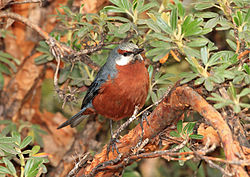| Giant conebill | |
|---|---|
 | |
| Scientific classification | |
| Kingdom: | Animalia |
| Phylum: | Chordata |
| Class: | Aves |
| Order: | Passeriformes |
| Family: | Thraupidae |
| Genus: | Conirostrum |
| Species: | C. binghami |
| Binomial name | |
| Conirostrum binghami (Chapman, 1919) | |
 | |
| Synonyms | |
Oreomanes fraseri | |
The giant conebill (Conirostrum binghami) is a small passerine bird, one of the tanager family. It is closely related to the regular conebills Conirostrum though it differs in its larger size and nuthatch-like foraging habits.
Contents
The giant conebill is 15 centimetres (5.9 in) in length and weighs 22–27 grams (0.78–0.95 oz). It is grey above, deep chestnut below, and with a white patch on the cheeks. It is found in the Andes from Colombia to Ecuador, and Peru to Bolivia. It lives in Polylepis trees of the family Rosaceae.
The giant conebill lives individually or in groups of 5 or less. It peels bark off Polylepis trees to find insects. It also eats aphids and sugary solutions secreted by Gynoxys . The species is a seasonal breeder, nesting at the start of the rainy season (September to December in Bolivia where it has been studied). The nest is an open cup set on the branches of Polylepis, and the average clutch size is 1.8 eggs. Both parents incubate the eggs, feed the chicks and remove the fecal sacs. [2]
Its decline is attributed to the destruction and fragmentation of Polylepis woodland.
